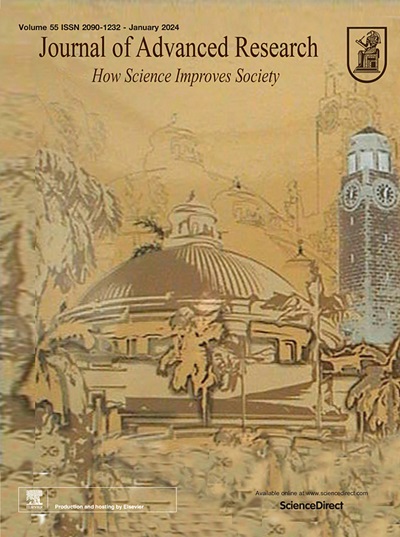5-氨基乙酰丙酸通过FaWRKY70和FaWRKY40调控的NO-H2O2信号通路提高草莓耐盐性
IF 13
1区 综合性期刊
Q1 MULTIDISCIPLINARY SCIENCES
引用次数: 0
摘要
5-氨基乙酰丙酸(ALA)是四吡咯化合物的重要生物合成前体,天然存在于所有生物体内。它也被认为是一种新的植物生长调节剂。ALA处理促进了盐胁迫下草莓Na+的稳态。这一过程的调控需要信号分子一氧化氮(NO)和过氧化氢(H2O2),但具体的信号级联和转录调控机制此前尚未被表征。目的研究FaWRKY70-FaWRKY40参与ala改善草莓Na+稳态和耐盐性的NO和H2O2信号级联及其转录调控机制。方法通过转录组和RT-qPCR初步证实FaWRKY40和FaWRKY70参与了ala诱导的草莓耐盐性。利用两个WRKY转录因子在林地草莓和烟草中过表达,鉴定了WRKY基因在耐盐性中的功能。利用酵母单杂交(Y1H)、β-葡萄糖醛酸酶(GUS)、双荧光素酶报告基因(DLR)和电泳迁移转移(EMSA)实验验证了与目标基因的相互作用。结果sala诱导NO和H2O2产生,形成由FaNR1和FaRbohD表达相互调控的信号通路,协调Na+稳态。研究表明,FaWRKY40在这一途径中起着正转录因子的作用:FaWRKY40过表达提高了林地草莓和烟草的耐盐性,而FaWRKY40 RNA干扰则增加了植物的盐损伤。FaWRKY40与FaRbohD、FaNHX1和FaSOS1启动子结合,促进根系H2O2生成和Na+再分配。相反,研究发现WRKY负转录因子FaWRKY70通过抑制FvWRKY40、FvNR1和FvHKT1的表达而增加盐敏感性。ALA抑制了FaWRKY70的表达,增加了FaWRKY40的表达,协调了草莓在盐胁迫下NO-H2O2信号通路和Na+稳态的调节。结论ala抑制nacl刺激的FaWRYK70表达,减轻其下游靶点的转录抑制。NO-H2O2信号通路可以启动Na+排斥、液泡封存和木质部汁液中Na+的去除等机制,限制Na+在叶片中的积累,促进Na+稳态和植物耐盐性。本文章由计算机程序翻译,如有差异,请以英文原文为准。


5-Aminolevulinic acid improves strawberry salt tolerance through a NO–H2O2 signaling circuit regulated by FaWRKY70 and FaWRKY40
Introduction
5-Aminolevulinic acid (ALA) is an essential biosynthetic precursor of tetrapyrrole compounds, naturally occurring in all living organisms. It has also been suggested as a new plant growth regulator. Treatment with ALA promotes strawberry Na+ homeostasis under salt stress. Regulation of this process requires the signaling molecules nitric oxide (NO) and hydrogen peroxide (H2O2), but the specific signaling cascade and transcriptional regulatory mechanism have not previously been characterized.
Objectives
Our work focused on the dissection of the NO and H2O2 signaling cascade and transcriptional regulatory mechanism by which FaWRKY70-FaWRKY40 participated in ALA-improved Na+ homeostasis and salt tolerance of strawberry.
Methods
It was preliminarily confirmed by transcriptome and RT-qPCR that FaWRKY40 and FaWRKY70 participated in ALA-induced salt tolerance of strawberry. Two WRKY transcription factors overexpressed in woodland strawberry as well as tobacco were used to identify the gene functions in salt tolerance. Yeast one-hybrid (Y1H), β-glucuronidase (GUS), dual luciferase reporter (DLR) and electrophoretic mobility shift assays (EMSA) were used to verify the interaction with the target gene.
Results
ALA induced NO and H2O2 production, which formed a signaling circuit reciprocally regulated by FaNR1 and FaRbohD expression to coordinate Na+ homeostasis. FaWRKY40 was shown to act as a positive transcription factor in this pathway: FaWRKY40 overexpression improved salt tolerance in woodland strawberry and tobacco, whereas FaWRKY40 RNA interference increased plant salt injury. FaWRKY40 bound to the promoters of FaRbohD, FaNHX1, and FaSOS1 to promote root H2O2 generation and Na+ reallocation. Conversely, FaWRKY70, a negative WRKY transcription factor, was found to increase salt sensitivity by inhibiting expression of FvWRKY40, FvNR1, and FvHKT1. ALA inhibited FaWRKY70 but increased FaWRKY40 expression, coordinating the regulation of NO-H2O2 signaling and Na+ homeostasis when strawberry was stress by salinity.
Conclusion
ALA inhibits NaCl-stimulated FaWRYK70 expression, relieving the transcriptional inhibition of its downstream targets. The NO–H2O2 signaling circuit can then initiate mechanisms such as Na+ exclusion, vacuolar sequestration, and removal of Na+ from the xylem sap, limiting Na+ accumulation in the leaves and promoting Na+ homeostasis and plant salt tolerance.
求助全文
通过发布文献求助,成功后即可免费获取论文全文。
去求助
来源期刊

Journal of Advanced Research
Multidisciplinary-Multidisciplinary
CiteScore
21.60
自引率
0.90%
发文量
280
审稿时长
12 weeks
期刊介绍:
Journal of Advanced Research (J. Adv. Res.) is an applied/natural sciences, peer-reviewed journal that focuses on interdisciplinary research. The journal aims to contribute to applied research and knowledge worldwide through the publication of original and high-quality research articles in the fields of Medicine, Pharmaceutical Sciences, Dentistry, Physical Therapy, Veterinary Medicine, and Basic and Biological Sciences.
The following abstracting and indexing services cover the Journal of Advanced Research: PubMed/Medline, Essential Science Indicators, Web of Science, Scopus, PubMed Central, PubMed, Science Citation Index Expanded, Directory of Open Access Journals (DOAJ), and INSPEC.
 求助内容:
求助内容: 应助结果提醒方式:
应助结果提醒方式:


